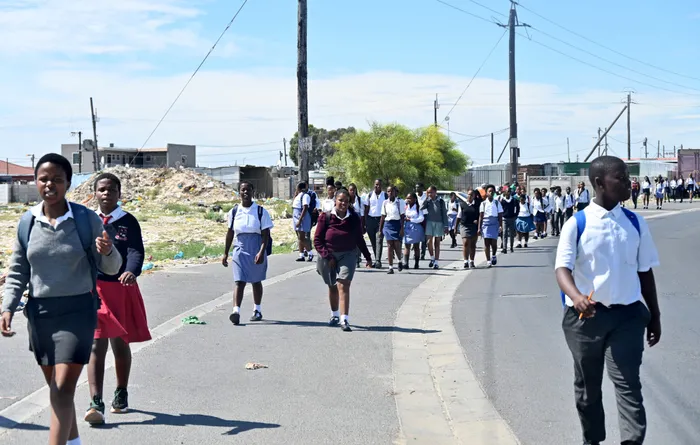Alarm bells over high drop-out rate

Picture: Ayanda Ndamane / African News Agency (ANA) – Learners walking to school from Mfuleni to Silversands. According to the Unicef (UN International Children’s Education Fund), about 250,000 children drop out of school every year.
By Zanele Zuma
Pupils dropping out of school is a global phenomenon, but it has tremendous negative effects on communities in developing countries, including South Africa.
According to the Unicef (UN International Children’s Education Fund), about 250,000 children drop out of school every year. This figure tripled to 750,000 during the Covid-19 pandemic.
Research has shown alarming rates of South African pupils who drop out of school, and it is presumably escalating. According to a report by Statistics South Africa (Stats SA 2022), close to 3 percent of 15-year-olds and nearly 9 percent of 17-year-olds dropped out of school in 2021.
Research reveals that in 2010, 1.1million pupils enrolled for Grade1. Of these 1.1 million first-school entries, only 755,981 enrolled for their National Senior Certificate last year. The number of pupils who enrolled for matric last year was 22,783 more than the previous year in which a total of 733,000 pupils were enrolled. These figures indicate that pupils dropping out of school continues.
Pupils drop out of school in all grades; however, the major focus has been on the Further Education and Training band, especially Grade 12.
Before the release of the 2022 matric results, Katherine Sutherland, from Equal Education Research, said that foundational numeracy and literacy was fundamental for the success of pupils at school. She called on the government to support pupils from Grade 1. She also emphasised the importance of government intervention, not only for Grade 12 pupils but also for those in all grades.
Not understanding teachers in class is one of the many causes of pupils dropping out. Pupils who leave school prematurely lack access to higher education, have fewer job opportunities and lower wages than their peers who finished their schooling (StatsSA 2022).
Research demonstrates that education is essential for improving the socio-economic state of households. South Africa, with its crawling economy, high youth unemployment rate and political uncertainties cannot afford to face escalating rates of pupil drop-out.
The 2022 matric cohort faced insurmountable odds to get to their last grade. In 2020, when they were in Grade 10, they had to transition to virtual learning because of Covid-19.
Many of these pupils had to skip attending some days of school to allow other pupils a chance to attend to comply with Covid-19 regulations.
The Grade 10 curriculum for the 2022 matric cohort was not completed in 2020, and this gap may have in some way led to some pupils dropping out.
This factor further widened the black-white gap in drop-out rates for pupils of the same cohort. By implication, factors considered to have impacted this gap in the past, coupled with those of Covid19, hit the black communities hard, especially because they are already disadvantaged in terms of poor infrastructure, fewer resources (material, human and financial), overcrowded classrooms, socio-economic dispensation and a number of other actors.
Research on school drop-out rates for boys and girls shows significantly different patterns by gender (Shahidul and Karim 2015 and Statistics South Africa 2022). Reasons given for leaving school differ by gender, especially for girls, who have to stop attending school due to family commitments (13.4 percent), while close to 5 percent of males stopped attending school because they had no interest in education (StatsSA 2022).
It is thus advisable that the cases of pupils leaving school before completing Grade 12 be addressed by gender to be able to find the causes of their plight and to address it.
Among the other factors linked to school drop-out rates is teenage pregnancy, which contributes to high girl-child absences from school. Motherhood responsibilities coupled with home chores and schoolwork weigh heavily on girls.
Subsequently, their male counterparts in class outperform them. Furthermore, the high probability of pupil pregnancy linked to gender-based violence is of great concern and needs urgent attention.
Again, pupils who rent residential accommodation to be close to school are vulnerable to strangers, who may sexually abuse girls, assault boys or even convince pupils in favour of a cohabiting living arrangement.
Most of these pupils do not make it to matric and there seems to be minimal government visibility in addressing this, particularly at the school level. Even follow-ups to trace the whereabouts of pupils who have dropped out of school are not initiated.
Dr Zanele Zuma, School of Public Health at Wits University